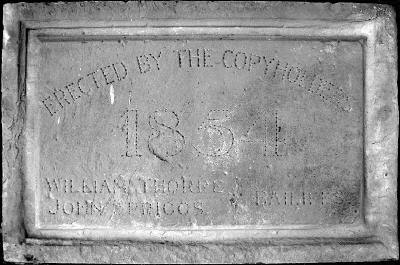|
Cottingham
is fed by spring water which seeps down through the
limestone to emerge in wells and springs around the village. Even
today, water trickles across the aptly named 'Water Lane' from nearby
springs.
In 1854, the village
Copyholders provided a
water supply for the village utilising the spring above Water Lane which
gave a reliable flow of fresh water. A pump and water trough was installed
in the centre of the village, above which was installed a stone tablet
commemorating the event. The
words and numbers on the stone (pictured
below), were originally made of lead pegged into the stone and read 'Erected by the Copyholders,
1854, William Thorpe, John Spriggs, Bailiffs'.
There were a number of other pumps installed,
and an iron trough placed below an outlet pipe in the churchyard wall, to
collect the overflow.

The earliest record of payments collected from
villagers by the Copyholders is dated 1884, when the price charged for
each tap installed was 1 shilling. That year, 12 households in
Cottingham and nine in Middleton made payments. The only houses which
could benefit from the supply were those situated where there was
sufficient head of water to make a reasonable flow when the tap was turned
on. The remainder of the villagers had to be content with water from the
many wells in the village.
The 1890 Kelly's
Directory refers to the water supply saying: "A supply of excellent
water from springs adjacent to the village is carried throughout
Cottingham and the adjoining township of Middleton in iron pipes with
drinking fountains at intervals. The pipes were laid back at the expense
of the Copyholders in 1854."
In 1919, the copyholders
borrowed money in order to put in new galvanised pipes to improve the
system, and after this was completed the charge per tap was increased from
1 shilling to 5 shillings. A transcript of the
minutes of the
Copyholders' meeting where these improvements were agreed are
attached.
In 1923, when the
Millfield estate was built, a deep well was sunk in an attempt to provide
water for the houses but none was forthcoming. The well was deepened
further and a hand-operated machine was installed, consisting of an
endless belt of cups to collect water and bring it to the surface, but the
scheme was soon abandoned, and a farmer used to take a water cart up to
estate each day.
By 1934 a small number of
water closets were operated from Copyholders’ supply. In 1937, money
collected for the use of water was a total £10 for Cottingham and £8 for
Middleton.
In his book 'The King's England, Northamptonshire' (1945) Arthur Mee says: "a primitive water supply
still carries spring water through the village in iron pipes, with
drinking fountains at intervals."
David Dodd, who lived on
Frog Island, Rockingham Road in the
1940s recalls: "Water had to be fetched in buckets from a hand
operated pump situated about 20 yards down the garden. Sometimes in winter
the pump would freeze up, refusing all efforts to thaw it out. Then it
meant a trip to the pump at the 'Cross' and an arduous climb back up the
hill to Frogs Island. Bath-time was quite a performance. A galvanised bath
was placed on the floor in front of the fire and hot water ladled from the
'copper' in the scullery into the bath with cold water added as necessary.
The grown-ups had to wait their turn until the children were in bed, using
a larger bath-tub."
There are still
two water troughs in Church Street. However, the wellhead, pump and wooden trough
that used to stand in the centre of the village on the corner of Corby
Road and Rockingham Road 'The Cross') were dismantled in the 1960s.
Mains water was installed in the village in
1957.
With thanks to Colin Bradshaw and
Michael Curtis for providing the Copyholder information.
|